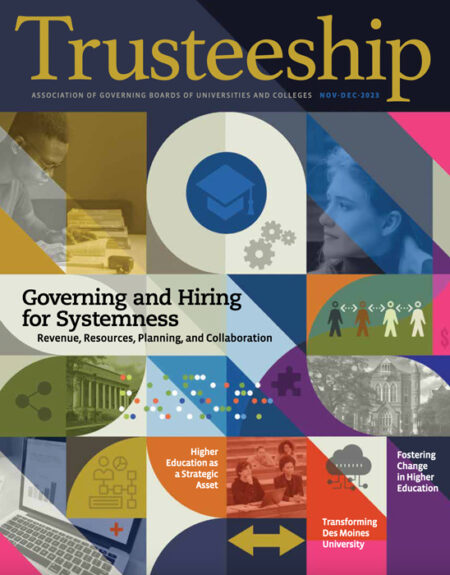
As the novelist Charles Dickens wrote long ago, “It was the best of times, it was the worst of times, it was the age of wisdom, it was the age of foolishness.” I am sure these words resonate for many of us in higher education today.
Over the past decade, during my tenure as president at two different institutions and as a board member, I, like many of you, wrestled with the myriad challenges disrupting colleges and universities. Ranging from strained budget models and public skepticism about the value of a college degree, to academic integrity, the risks associated with new technologies, and threats to our democracy, these challenges must concern all of higher education’s advocates.
Yet challenging times also can—indeed must—become moments for innovation and a renewed commitment to mission, particularly around student success, even if some of our practices might require fundamental redesign. We inhabit a rare moment when we—board members, presidents, senior staff, faculty members, and partners—must consider how to transform our colleges and universities in creative ways. Such change will take courage and vision from boards and institutional leaders working together. As I enter my fourth month as AGB’s executive vice president, I look forward to exploring emerging ideas that amplify higher education’s collective wisdom, forged from necessity, innovation, and partnerships.
Also, for many AGB members, this period marks the beginning of budget season. In my experience, innovation has everything to do with budgeting. Too often, the budget process leads not to innovative change, but to narrow and safe thinking. There is a budget to be balanced, after all, so we can’t afford to innovate or take risks.
On the contrary, I suggest that boards and institutional leaders need to resist the urge to play it safe and focus on reductions and cuts; instead, focus on investments in innovation and change. Reductions might allow your institution to hang on, but it may not thrive. The bottom line is innovation is our greatest asset to propel higher education forward from industrial age models that still dominate much of our design to the ever-evolving, ever-iterating digital age. Innovation is a mindset, a culture, a commitment to a sustainable future, and it needs the governing board to be its greatest champion.
Although innovation may look different on every campus, the five principles laid out in the AGB Board of Directors’ Statement on Innovation in Higher Education are a useful guide:
- Innovation in higher education requires a focus on current and long-term priorities and aspirations.
- Innovation depends on an active commitment to building and sustaining a culture of institutional collaboration.
- In fostering a culture of innovation, the governing board should be clear in its support for presidential leadership.
- Innovation requires a governing board’s readiness for change, a willingness to accept and monitor risk, and a structure that ensures proper oversight and participation in innovation.
- Innovation requires a sufficient commitment of resources.
- Successful innovation demands the governing board’s attention to the strategic role of technology.1
I find these principles not only valuable in the context of budget oversight but also necessary to ensure innovation supports student success and institutional health. Through the review process, boards can demonstrate readiness for change and digital transformation, while ensuring there are resources to drive innovation on campus. It is less about “right-sizing” and more about rethinking our needs for a new era. Moreover, board members should seek to understand how to leverage innovation not just for this budget cycle, but for the next five, ten, or even 20 years.
I hope you will consider joining me early in 2024 to discuss innovation and the future of higher education at AGB’s upcoming conferences: the Foundation Leadership Forum, the Board Professionals Conference, and the National Conference on Trusteeship. As any Silicon Valley entrepreneur will tell you, no good idea comes from a vacuum. AGB conferences are the perfect setting in which to share beyond your neighbors and peer institutions to the more than 1,000 boards that make up the AGB membership.
Let us use today’s challenges to usher in a higher education renaissance, together.
Mary Papazian, PhD, is executive vice president of AGB.
Notes
1. Association of Governing Boards of Universities and Colleges, AGB Board of Directors’ Statement on Innovation in Higher Education (Washington, DC: AGB, 2017).


